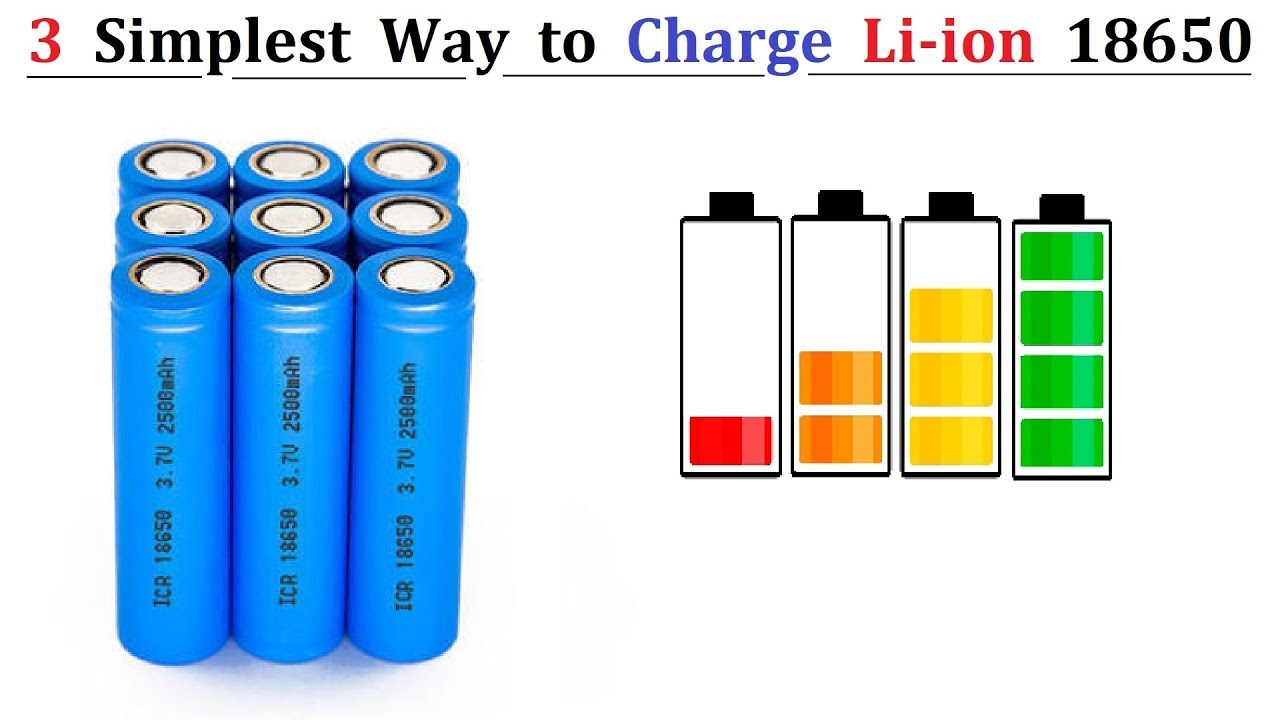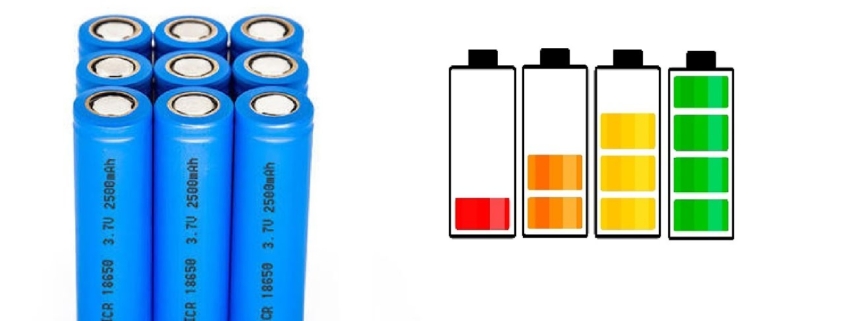How to Charge 18650 Battery Safely in 2024
Lithium-ion 18650 batteries have become extremely popular in recent years. As more devices adopt 18650 batteries as their power source, learning how to properly charge 18650 batteries is critical for performance and safety. In this comprehensive guide, as a professional 18650 battery packs manufacturer, I’ll walk you through the fundamentals of charging the 18650 batteries so you can get the most out of them.

Overview of 18650 Battery Charging
First, what exactly are 18650 batteries? The 18650 battery is a lithium-ion battery that gets its name from its dimensions – 18mm diameter and 65mm height. With high energy density and capacity ranging from 2,000mAh to 3,500mAh, 18650s are the preferred battery type for high-drain devices like vapes, power tools, and even electric vehicles.
When it comes to charging, 18650 batteries use a two-stage charging process:
- Constant Current (CC) – In the first rapid charging phase, these batteries are charged at 1C (the battery capacity) until they reach 4.2V. For a 3,000mAh battery, 1C equates to a 3A charging current.
- Constant Voltage (CV) – Once the voltage threshold is achieved, charging enters the second phase whereby voltage remains fixed at 4.2V while current gradually tapers. This prevents overcharging.
Now let’s look at some best practices for safely charging 18650 batteries.
Choose an Appropriate 18650 Charger
I highly recommend getting a charger designed specifically for lithium-ion batteries over makeshift methods. The right 18650 battery charger implements charging profiles tailored to these batteries.
Here are some key factors to evaluate when selecting a charger:
Compatibility With Battery Chemistry
Ensure compatibility with major lithium-ion battery types – IMR, INR, ICR – before purchase. Chargers like the XTAR VP4 Plus support various chemistries.
Number of Bays
Multi-bay chargers allow simultaneously charging multiple 18650 batteries. For instance, the Folomov A4 fits 4 batteries at once. This saves time if you own multiple batteries.
Charging Speed/Current
Higher current rating means faster charging. When looking for fast charging, choose options with at least 1A output per bay. Just be mindful of heat. The Nitecore SC2 charges at up to 750mA per battery.
Safety Features
Advanced protections prevent overcharge, reverse polarity, overheating while an LED interface displays charge status. The Liitokala Lii-500 offers these safety mechanisms.
Portability
Compact USB-powered chargers like XTAR MC1 make charging on-the-go convenient for travelers. But output is lower (500mA) due to power limitations.
After covering the basics, let’s explore in detail the best practices for charging 18650 batteries.
How to Charge 18650 Battery: Step-by-Step Guide
Follow this straightforward process for secure handling and optimal performance:
1. Check Battery Voltage First
Before charging, check voltage using a meter to determine state of charge and the need for revival/balancing:
- 3.6V – 4.2V – Go ahead and charge normally
- 3.3V – 3.5V – Top balance then charge
- <3.0V – Attempt to revive first
Discharged cells below 3.0V require revival before charging.
2. Inspect Externally
Visually inspect batteries prior to charging. Look for:
- Damaged positive terminal
- Torn battery sleeve
- Signs of leakage/swelling
Damaged batteries are prone to heating and should be disposed of properly. Never charge if batteries are hot or malfunctioning.
3. Use The Right Charger
I cannot emphasize enough the importance of the proper lithium-ion charger for charging 18650 batteries. Benefits include:
- Applies optimal constant current/voltage
- Balances cells
- Prevents overcharging
- Extends longevity
Using a mismatched charger carries risks of damage, inefficient charging and overcharging accidents.
4. Slot Batteries Correctly
If using a multi-bay charger, position all cells with proper polarity – positive (+) and negative (-) oriented correctly:
18650 Battery Slotted Correctly
Reversing battery polarity generates abnormal energy flow causing catastrophic failure. Always double check!
5. Monitor During Charging Cycle
Vigilantly monitor the charging process. Check for:
- Fluctuating current levels
- Cells heating up
- Uneven charge balance
Troubleshoot or safely terminate charging if anomalies occur. As an example, the GYRFALCON ALL-88 analyses cells and stops charging when unsafe deviations are detected.
6. Disconnect Once Fully Charged
Constant monitoring lets you promptly disconnect batteries once the charging cycle completes, usually indicated by LED indicators turning green. Never overcharge as it degrades battery health over time.
And those are the key steps that warrant safe charging practices for optimal 18650 battery lifespans and performance.
While mostly straightforward, improper handling of lithium-ion batteries carries serious risks. By adopting safety fundamentals, you can avoid unfortunate incidents and unlock the full potential of these incredibly versatile batteries.
How to Charge 18650 Battery without Charger?
Charging a 18650 battery without a dedicated charger can be done but comes with risks like overcharging, overheating, or damaging the battery. However, if you still want to proceed, here are some alternatives:
Using a USB Cable/Power Bank
To charge the battery, simply connect it to the power bank using the appropriate cable and turn on the power bank.
This method involves connecting your 18650 battery directly via a USB cable from a device capable of providing sufficient voltage (typically around 5V). Ensure correct polarity (+ to +, – to –) during connection.
However, it’s important to note:
The current supplied by these sources might not match what the battery needs optimally.
There may lack necessary protections against over-charging, which could harm the battery.
How to Charge 18650 Battery with Phone Charger?
To charge a 18650 battery using a phone charger (which typically outputs USB power), follow these steps:
Important Safety Note:
Using a standard phone charger directly might not provide the correct voltage and current needed for safely charging a 18650 lithium-ion battery. Always ensure compatibility between your charger and the battery.
Recommended Method:
If you want to use a mobile charger, consider purchasing a USB-powered 18650 battery charger. These devices convert USB output to the appropriate voltage and current required by 18650 batteries.
However, if you still wish to proceed with modifying a regular phone charger, here’s what you need to know:
Step-by-Step Process:
- Selecting the Right Phone Charger:
- Choose a high-current-rated mobile charger capable of providing at least 2A (amperes). This ensures sufficient current flow without overheating.
- Building Your Own Adapter:
- If necessary, build an adapter that converts the USB output to match the requirements of your 18650 battery. Typically, this involves creating a DC-to-DC converter circuit.
- Alternatively, purchase pre-made adapters available online or in electronics stores.
- Connecting the Battery:
- Connect the positive terminal of the 18650 battery to the red wire coming out of the adapter.
- Connect the negative terminal of the 18650 battery to the black wire coming out of the adapter.
- Plugging In:
- Once everything is connected properly, plug the other end of the adapter into your phone charger.
- Then, connect the phone charger to a power source, such as a wall socket.
- Monitoring:
- Monitor the temperature of both the adapter and the battery during charging. Overheating can lead to serious issues including fire hazards.
- Consider investing in a smart charger that includes built-in protection features against overcharging, short-circuiting, etc.
Cautionary Measures:
- Avoid direct connection of a 18650 battery to a USB port; always use proper conversion equipment.
- Do not leave unattended while charging.
- Use only quality components when building custom circuits to avoid electrical malfunctions.
By following these guidelines, you should be able to safely charge your 18650 battery using a modified phone charger setup. However, for simplicity and reliability, specialized 18650 battery chargers are highly recommended.
How to Charge 18650 Battery with Solar Panel?
To charge a 18650 battery with a solar panel, follow these steps:
- Select Appropriate Equipment: Choose a solar panel whose output voltage matches or slightly exceeds the fully charged voltage of your 18650 battery (around 4.2V per cell). If you’re dealing with multiple cells in series, multiply this by the number of cells.
- Use a Charge Controller: Connect the solar panel to a suitable charge controller designed for lithium-ion batteries. The charge controller regulates the flow of electricity from the solar panel to the battery, preventing damage due to overcharging and ensuring efficient charging rates.
- Connect Safely: Ensure all connections between the solar panel, charge controller, and battery are secure and properly insulated to avoid short circuits or electrical hazards.
- Position Properly: Place the solar panel where it receives maximum sunlight throughout the day. Tilt the panel towards the sun’s position during peak hours for better efficiency.
- Monitor Charging Status: Keep track of the charging process through indicators provided by the charge controller or via monitoring devices connected to the system. It’s important to know when the battery reaches full charge to disconnect it promptly.
By following these guidelines, you can efficiently and safely charge your 18650 batteries using solar energy.
Safe Usage and Storage
I’ll conclude by highlighting vital usage and storage guidelines regarding lithium-ion 18650 batteries:
- Avoid extremely high discharge rates
- Don’t discharge too deeply before recharging
- Store around 50% charge at room temperature
- Prevent exposure to high ambient heat
- Use a protective case when storing or traveling
- Check voltage every 6 months when storing long-term
- Be mindful when connecting in series or parallel
Observing these simple practices coupled with the charging basics covered earlier will go a long way in maximizing safety and battery lifespan.
The applications for 18650 lithium-ion batteries continue expanding at an incredible rate. By responsibly adopting safety fundamentals during charging, usage and storage, you can fully harness the power of these batteries and accelerate innovation.








